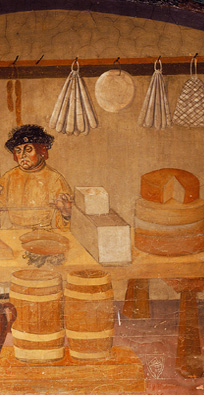Fontina facts for kids
Quick facts for kids Fontina |
|
|---|---|
 |
|
| Country of origin | Italy |
| Region | Aosta Valley |
| Source of milk | Cows |
| Pasteurized | No |
| Texture | semi-soft |
| Fat content | 45% |
| Certification | EU: PDO 1996 |
| Named after | Lua error in Module:Wikidata at line 70: attempt to index field 'wikibase' (a nil value). |
Fontina (which is Fontine in French) is a delicious cheese made from cow's milk. It was first created in Italy. Over time, people loved it so much that Fontina cheese started to be made all over the world! You can now find it produced in places like the United States, Denmark, Sweden, Canada, France, and Argentina.
Contents
What is Fontina Cheese?
Fontina is a cheese that can be anywhere from a bit soft to quite firm. It has a mild to medium-strong flavor. About 45% of Fontina is milk fat. The special taste of Fontina is mild, but it has a distinct nutty and savory (or salty and yummy) flavor.
Fontina from countries like Sweden, Denmark, and the United States often tastes milder. It also feels softer and has more holes inside than the Fontina made in Italy.
Where Does Fontina Come From?
The original Fontina cheese has been made in the Aosta Valley in the Alps mountains since the 12th century. That's a very long time ago!
If you buy Fontina cheese in the EU, you can look for a special stamp. This stamp is from a group called the Consorzio (which means Consortium). It shows the Matterhorn mountain and the word "FONTINA". This stamp helps you know it's the real deal from the Aosta Valley.
Different Kinds of Fontina
Just like many other famous cheeses, the name "Fontina" has led to similar names like "Fontinella," "Fontal," and "Fontella." While the Fontina from the Aosta Valley is the original and most famous, similar cheeses are made in other parts of Italy. They are also made in Denmark, Sweden, Quebec (in Canada), France, Argentina, and the United States.
You might often see Swedish and Danish versions of Fontina in grocery stores. You can tell them apart from Aostan Fontina because they usually have a red wax rind (the outer layer). Argentine Fontina also often has this red wax.
How Original Fontina is Made
The original Fontina cheese from the Aosta Valley must be made in a very specific way. It uses milk that has not been pasteurized (heated to kill germs). This milk comes from a single milking of a special type of cow called a Valdostana. Cheese makers make two batches of cheese each day.
What Does Original Fontina Look Like and Taste Like?
The original Fontina cheese from the Aosta Valley has a strong and intense flavor. However, cheeses labeled "Fontina-like" from other countries can be much milder.
Aostan Fontina has a natural rind that forms as it ages. This rind is usually tan to orange-brown. The inside of the cheese is a pale cream color. It has many small holes, which are called "eyes" in cheese making.
People say Fontina has an earthy, mushroomy, and woody taste. It tastes great with roasted meats and truffles. It has a rich and creamy flavor that becomes nuttier as the cheese gets older. When Fontina is fully aged, it becomes a hard cheese and melts very well.
Protected Name for Aostan Fontina
Fontina cheese sold in the EU has a special status called "Protected Designation of Origin" (DOP). This means that only cheese made in a certain way and from a specific region can use the name "Fontina" in the EU.
The rules for Aostan Fontina DOP say that the cheese must be made from unpasteurized milk. This milk must come from a single milking of a Valdostana breed of cow. Also, two batches of cheese must be made each day. This helps keep the cheese unique and special.
Cooking with Fontina
Young Fontina cheese is softer, which makes it perfect for fondue. Fondue is a fun dish where you melt cheese and dip bread or other foods into it.
A traditional dish from the Aosta Valley is called Fonduta alla valdostana (in Italian) or Fondue à la valdôtaine (in French). This dish is made by whipping Fontina with milk, eggs, and truffles.
Fontina also tastes great with Nebbiolo, which is a red wine that has flavors of wild cherry and truffles.
"Fontina" as a General Name
In 1986, a court in the United States decided that "fontina" was a general name for a type of cheese. It was not just a name for cheese from a specific region. This means that producers outside the Aosta Valley can also use the term "fontina" for their cheeses.
Today, Fontina cheese is made in many countries around the world. These include the United States, Denmark, Sweden, Quebec, France, and Argentina.
See also
 In Spanish: Fontina para niños
In Spanish: Fontina para niños


